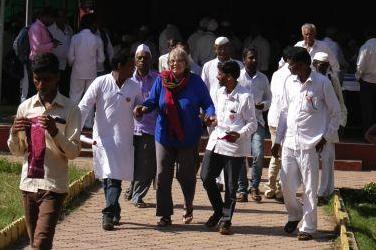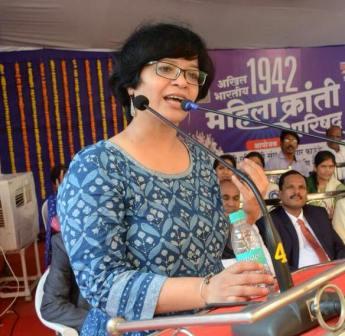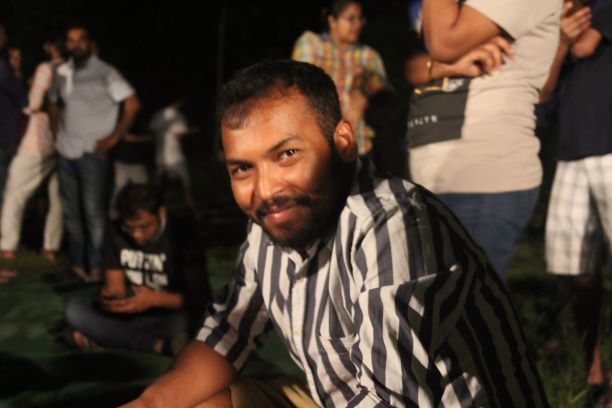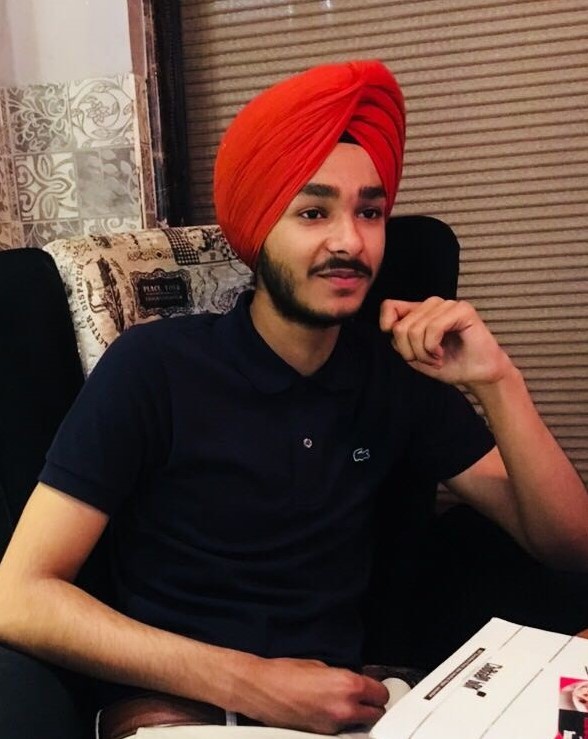Sampat Desai
 Reconstruction of the world is the basic function of philosophy; philosophy should not spend time analyzing the origin of the world. Dr. Gail Omvedt used the above principle and contributed significantly to this theory. She gave a new insight to the research field putting forth a new theoretical framework with special reference to Buddhism, Brahminism and ethnicity in India. She dealt with ancient, medieval and modern times examining them critically through her research and writings. Most researchers dissociate themselves from society and follow neutrality. They keep a safe distance from the struggle for social change. Dr. Gail proves to be an exception. Relentlessly, she carried out a lot of research and study, linking her philosophy and theory to the struggle for change. Thus, she was recognized by the whole world as an organic intellectual. 
Reconstruction of the world is the basic function of philosophy; philosophy should not spend time analyzing the origin of the world. Dr. Gail Omvedt used the above principle and contributed significantly to this theory. She gave a new insight to the research field putting forth a new theoretical framework with special reference to Buddhism, Brahminism and ethnicity in India. She dealt with ancient, medieval and modern times examining them critically through her research and writings. Most researchers dissociate themselves from society and follow neutrality. They keep a safe distance from the struggle for social change. Dr. Gail proves to be an exception. Relentlessly, she carried out a lot of research and study, linking her philosophy and theory to the struggle for change. Thus, she was recognized by the whole world as an organic intellectual. 
Dr. Gail who passed away on August 25, 2021, at the age of 81 was a Buddhist, a Phule, an Ambedkarite, a Marxist and a feminist thinker. She was a researcher of Saints’ literature and Varkari philosophy, an activist for the abandoned, for Women’s Liberation, for the Dalits, for the Adivasis and she was an upfront runner for the eradication of the caste system. She was born on August 2, 1941, into a wealthy middle-class family in Minneapolis, Texas. Her grandfather was elected to the U.S. senate from the Democratic Party, and her father had been the mayor of the city for 3 terms. With such a political legacy, she was drawn to Marxism while pursuing her college education. At that time there was a strong movement in the U.S. against the belligerent imperialistic and war loving policies of the U.S establishment. She was at the forefront of this movement and was imprisoned because of it. Upon being released from prison she felt restless and finally decided to move to India.
Dr. Gail reached India in her youth to study the social movements here. She was so taken by her studies that she became part of the movement. Instead of being only a guide for the Dalits, Adivasis, farm workers, she became their co-warrior/comrade in their struggle. She became their friend. Basically, a researcher, Gail was a sociology scholar. She chose, ‘Cultural, Revolution/Revolt in the colonial society’ as her research subject. Her field of study was Satyashodhak in Maharashtra, especially in the western part of the state, between 1967 and 1972. Many research scholars prior to her were seen presenting their findings based only on the written documents and texts but Dr. Gail, along with these documents used a new way of carrying out research. She traveled the region which was under the influence of the Satyashodhak and Non-Brahmin movement that had spread far and wide in the villages of Maharashtra.
Before the arrival of Dr. Gail in India, the dominant ideological circle under Brahminical influence did not pay much attention to Phule’s and Ambedkar’s philosophy because they considered them untouchables and called them only Social Reformers. Their philosophy was never taken seriously by the elites and the learned. Dr. Gail for the first time reconstructed Phule’s and Ambedkar’s philosophy and brought them to the forefront in the field of knowledge and academics. The results of her studies caused a great upheaval. As a result of this upheaval the Satyashodhak Movement, the Non-Brahmin movement, and Ambedkar’s movement became the topics of study and research for many.
In her book, ‘Challenging Buddhism, Brahminism, Ethnicity in India’, Gail proposes that India has to be renamed as Buddhist India and not Hindu India considering that Buddhism was the main religion of India between the fourth and sixth century BC. She discusses Ambedkar’s Buddhism critically. She feels that Babasaheb had a big fight with Buddhism while reconstructing it. He had to do a surgery too, although Ambedkar’s restructuring and treatment of Buddhism is a blow to traditional Buddhism, his revolutionary zeal is consistent with the original Buddhism. She has highlighted this in her book. She has raised many questions to the pro-Hindu interpretation of history, while interpreting in a new way the origin and development of the caste system.
Dr. Gail has played an important role in giving a new dimension to feminism in India. Earlier the Women’s Liberation movement used to be in the upper caste circle only. With Dr. Gail’s entry it changed. She was the first to give a new layout through revolutionary history to the Women’s Liberation movement in India. In her book, ’We Will Smash this Prison’, she unravels the patriarchy woven with caste factors. She developed a new way of looking at the history of the Cultural Revolution from Phule’s and Ambedkar’s points of view. She didn’t stop at just setting up a new feminism, but actively intervened in the problems of rural working women. She brought a pluralistic ideology to the feminist movement. She formed a strong union of the abandoned women with Indutai Patankar, a revolutionary who happened to be her mother-in-law and an active member of the then Patri Sarkar, that had been formed during the Freedom struggle. Dr. Gail was hand-in-hand with Indutai in this yeoman service. This highlights the special qualities of this highly educated and talented lady.
Although Indian society is based on the caste system, this has never been a topic of academic discussion. Dr. Dilip Chavan has said, “Dr. Gail was the first to make the caste system an academic subject 50 years ago”. He further says, before that, caste system emerged in Sociology only and that too only in a descriptive manner. Having a thorough understanding of Indian Sociology and History, Dr. Gail opened new avenues for the study of the caste system. Her research paper, ‘Cultural Dissent in Colonial Society’, begins with an interview of a Dalit female farmer. Dr. Gail applies a different method of research in her studies and examines the caste system of ancient, medieval and modern India. From, ‘Buddhism in India – Challenge to Brahmanism and Ethnicity’, ‘Seeking Begampura’, ‘Babasaheb Ambedkar’, ‘Tukaram Gaikwad’ to her dissertation topic, ‘Cultural Revolution in the Colonial Society’, Dr. Gail goes to the basics of the caste system with due diligence. She states clearly in her dissertation that colonialism is an external power whereas the caste system is an internal element of power.
After her arrival in India, Dr. Gail came in touch with the Lal Nishan (Red Flag) Party. She got associated with various revolutionary groups like, UKranD, Dalit Panther, Tribal Rights’ movements. Her Academic commitment was born out of her commitment to the people’s movements. In her book, ‘Seeking Begampura’ she looks at the world with love and affection. She left behind the traditional view of the devotional movement of the saints of South India and connected herself with saints like Namdeo, Ravidas, Kabir and Tukaram. She brought out the revolutionary nature of their tradition with a new historical perspective. Her book, ‘Seeking Begampura’ gave the progressive thinkers a new way to look at the devotional movement. Earlier, this devotional movement was neglected by the leftists, Phule, and Ambedkar. They had kept away from it. Dr. Gail tried to bring them together.
One must have proper discipline and system of study while doing research in Social Sciences. This and this only can validate your research. Dr. Gail was a visionary, and she recognized these things early. She disciplined herself and her studies. This shows that all her writing is not only meaningful but also constructive. She questions the development process while dealing with the new social movements. That, too, accurately. She states that too much demand of natural resources is the cause of environmental degradation. This demand is detrimental to the environmental and natural lifestyle of the Adivasis and forest dwellers. It destroys them completely and that makes her insist strongly on the new eco-friendly development process. She feels that there is no alternative to the peasants’ movement to eradicate casteism. She states that the environmental movement and the peasants’ movement must join hands. She did not stop at the philosophical and ideological points, but linked philosophy to change. Working at the grass-root level, she connected her philosophy with the movement for change. She took the initiative in establishing the Shramik Mukti Dal (A movement to free workers) with her husband Dr. Bharat Patankar. She didn’t remain on the philosophical or role model level but became an activist. She founded a movement for the socially abandoned in Walwa taluka of Sangli district. She was the flag bearer for justice for women abandoned by their husbands and living alone. She conducted the first conference for these women. This movement and agitation forced the government to take a policy decision regarding these abandoned women. This proved to be a revolutionary step for the Women’s Liberation movement.
Dr. Gail said that the main cause of caste oppression and injustice lies in the caste system. She strongly feels that caste eradication is the only solution to this malady. Without making much ado of being a research scholar, she remained always an activist, be it the long march against caste oppression or caste eradication conference. Day and night she tirelessly led the movement. Be it the struggle of the drought-ridden peasants of Khanapur, or the fight for the rehabilitation of Koyna Dam victims, she didn’t stop just by contributing to the development of revolutionary cultural movement but was an active participant in every event held by the movement. She had strong faith in the Varkari philosophy and Saint Movement. This made her remain at the forefront in the Badve Utpat Hatao movement arranged by the revolutionaries. Her contributions have been instrumental in the development of a new way of looking at Indian tradition and myths. The Vitthal Rukmini Mukti Andolan called by the Shramik Mukti Dal is the result of her critical interpretation of the Saint movement. In the recent agitation to free the Ambabai of Kolhapur initiated by the Shramik Mukti Dal, Dr. Gail was an active participant. She was deeply distressed by the assassinations of Dr. Narendra Dabholkar and Govind Pansare. She was also pained by the incidents of communal atrocities at Sonai Kharda in Maharashtra. She took part in the Pune to Kharda long march. She was a strong stakeholder in various agitations and movements – the social oppression movement, and the casteless society movement in various districts of Maharashtra. She was truly a researcher, a scholar, a sociologist and an activist.
Dr. Gail came to India and came across Buddha, Phule and Ambedkar. With a great yearning for knowledge and learning, she literally fell in love with them. She herself adopted the Buddhist philosophy which believes that the world is impermanent. It is always changing. While studying these great men, she could not understand how she, a Marxist, could turn to be an Amdedkarite. Dr. Gail, who was imprisoned when she was a student, fighting for freedom, equality, and justice found the struggle of this trio against the caste system more important. Dr. Gail, who had seen capitalistic exploitation, saw a different kind of exploitation in India. The caste system here denies the right of a man to be a man. It rejects humanity. It controls the man. She was awed by the revolutionary thinking of the trio. The trio said No to the caste system. This made her ‘Satyashodhak and Non-Brahmin Movement’ a topic of dissertation.
The trio believed that the caste system was not natural and could be abolished as it was man-made. They dreamt of a casteless and exploitation free society based on equality, rejecting all forms of discrimination. This we see in all her books including, ’Cultural Revolution in the Colonial Society”, “Seeking Begampura”, and “Towards Ambedkar’s Enlightenment”. Dr. Gail uses their theories for a struggle against the caste system and for a casteless society in all her writings. She writes in detail about the ancient Buddhism of India, the medieval devotional movement, the modern truth seekers, the post Brahminical and Ambedkarites and their anti- caste movement. Her research, her writings, her involvement in the labor movement, her sacrifice—all these have set a precedent for the new generation not only in India but the whole world. Many students from all over the world come to India to study the research she carried out through hard work and discipline. Indian society, its diverse culture, and its various social movements were always her major interest and study. Dr. Gail has written a lot to guide the movement of social change and to strengthen their ideological foundations. Gail’s insight and research on Abrahminic cultural movement in India are guidelines for the pluralistic movements. Her writings focusing on the caste issues show a different perspective. Buddha, Kabir, Ravidas, Namdeo, Tukaram, Phule, Ambedkar have always been her favorite subjects of study. This made her able to give a pluralistic vision to the local women’s liberation movement which had been trapped in the elite circle. She was such a great intellectual that she was called a Vidushi (the learned/wise one.) She passed away recently.
My heartfelt tribute to the departed soul.
~~~
Sampat Desai is a Writer and Socio–Cultural Activist from Ajara, Kolhapur.










